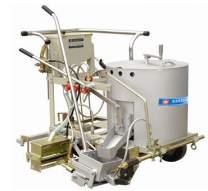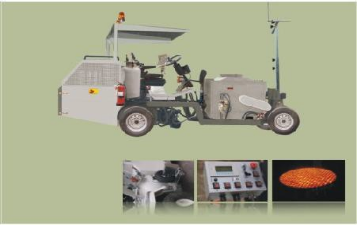Road safety.
Pre 1920’s
One of the earliest known applications of road markings can be traced back to ancient Mexico on a road near Mexico City sometime about 1600 A.D. The centerline was placed to separate opposing traffic and was created using lighter-colored stones in the pavement.
In more modern times the first painted stop lines were in Portsmouth,Virginia in 1907. The first markings for crosswalks were in New York City in 1911. The first lane lines were painted in 1912 in Cincinnati, Ohio, and the first centerline pavement markings were painted in 1918 in Detroit, Michigan.
History
1920’s solvent-based paint was developed
1930’s Thermoplastic marking materials were developed in the U.K. before World War II.
Minnesota Mining & Manufacturing (now 3M) started pressure sensitive markings.
1940’s In the U.S. glass beads were first mixed with pavement paint.
1950’s Hydrocarbon resin based hot applied thermoplastic material became popular.
1960’s Waterborne paints were developed but not popular.
1970’s Epoxy, Polyester, preformed, preformed thermoplastic, pressure sensitive, cold applied, pavement marking were developed.
1980’s Test decks started by SASHTO/NASHTO.
Through this series of articles, we will briefly introduce several common road markings composition, characteristics, and their advantages and disadvantages.
1. Hot Applied Thermoplastic Road Marking
|
Components |
Thermoplastic resins, pigment, CaCO3, glass beads, plasticizer, additives |
|
|
Appearance (normal temperature) |
Powder |
|
|
Heat residual |
>99% |
|
|
Paint Primer |
Needed for old road paving only |
|
|
Construction Temp |
Heat to melt (180°C-220°C) |
|
|
Construction mode |
Truck: Spray or screed/extrusion. Manual: Drag box |
|
|
Visibility |
day |
Good |
|
night |
Good |
|
|
Adhesion |
Medium |
|
|
Set-up time |
Fast |
|
|
Effect of glass bead |
Good |
|
|
Anti-pollution |
Medium |
|
|
Wear resistance |
Medium |
|
|
Service life |
10-30 months |
|
|
Effect on environment |
Little |
|
Primary use: long lines, intersection, arrows, letters, symbols;
Application: striping truck, spray/extrude, hand-liner, metal stencils, ribbon gun, etc.
Thickness: 1.5mm – 3.8mm
Resin System: hydrocarbon resin (C5 / C9); rosin ester; polyamide adhesive;
Appearance: powder form
Advantage: low cost; long life, fast dry, thick coating, good reflectivity;
Disadvantage: CaCO3 is 50% by weight (doesn’t travel well). Difficult to remove.
manual hot melt marking machine

